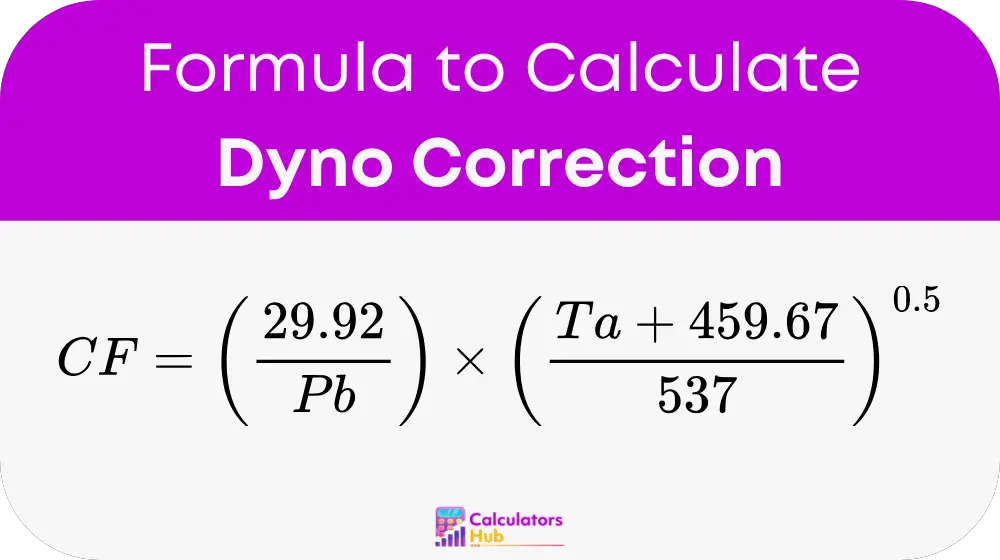The Dyno Correction Calculator adjusts engine power and torque numbers from a dynamometer (dyno) test to match standard conditions. A dyno measures how strong an engine is, but weather—like air pressure and temperature—can change the results. This tool fixes that by giving you a fair number no matter the day’s conditions. It falls under the category of automotive calculators, making it perfect for car enthusiasts, mechanics, or racers who want accurate performance stats.
Why is this helpful? If you test your car on a hot day with low pressure, the dyno might show less power than it really has. This calculator levels the playing field, so you can compare results from different times or places. It’s great for real-life decisions, like tuning an engine, picking upgrades, or bragging about horsepower with confidence. Plus, it’s reliable for important choices—like ensuring your car performs at its best. Want to see how it works? Let’s move to the formula next.
Formula for Dyno Correction Calculator
The formula for finding the correction factor (CF) is:

Where:
- CF = Correction Factor (a number to adjust power)
- Pb = Barometric pressure (inches of mercury, inHg)
- Ta = Ambient temperature (degrees Fahrenheit, °F)
- 459.67 = Converts °F to Rankine (°R)
- 537 = Standard temperature in Rankine (77°F + 459.67)
Then:
Corrected Power = Measured Power × CF
Corrected Torque = Measured Torque × CF
This formula comes from SAE standards (like SAE J1349), used in the car world to keep measurements fair. You divide the standard pressure (29.92 inHg) by the day’s pressure, adjust for temperature, and take the square root. Multiply your dyno numbers by the CF to get the corrected values. It’s a bit of math, but it makes results consistent. Now, let’s simplify it with a table.
Quick Reference Table for Correction Factors
Why calculate every time? This table shows correction factors for common weather conditions, so you can adjust fast.
| Barometric Pressure (inHg) | Temperature (°F) | Correction Factor (CF) |
|---|---|---|
| 29.92 | 77 | 1.00 |
| 29.50 | 90 | 0.97 |
| 30.10 | 60 | 1.04 |
| 29.00 | 100 | 0.94 |
How to Use the Table
- Find the day’s pressure and temperature.
- Check the CF in the third column.
- Multiply your dyno numbers by the CF.
This table helps with searches like “dyno correction for 90°F.” For exact conditions, use the formula. Next, let’s try an example.
Example of Dyno Correction Calculator
Suppose your dyno test shows 200 horsepower and 180 lb-ft of torque. The weather is 29.40 inHg and 85°F. You want the corrected numbers. Here’s how:
- Plug into the formula:
CF = (29.92 / Pb) × [(Ta + 459.67) / 537]^0.5
CF = (29.92 / 29.40) × [(85 + 459.67) / 537]^0.5 - Calculate step-by-step:
- 29.92 / 29.40 ≈ 1.018
- 85 + 459.67 = 544.67
- 544.67 / 537 ≈ 1.014
- [1.014]^0.5 ≈ 1.007
- CF = 1.018 × 1.007 ≈ 1.025
- Adjust the readings:
- Corrected Power = 200 × 1.025 = 205 hp
- Corrected Torque = 180 × 1.025 = 184.5 lb-ft
So, the corrected power is 205 hp, and torque is 184.5 lb-ft. This matches standard correction methods and gives a truer picture.
Most Common FAQs
Dyno correction adjusts for weather changes—like heat or air pressure—that affect engine power readings. It gives you a standard number, so you can compare your car’s performance fairly, no matter where or when you test it.
Check a local weather station or use a barometer and thermometer at the test site. Most dyno shops record these numbers during the test, so you can ask for them to plug into the calculator.
Yes, it works for any engine tested on a dyno—cars, trucks, or bikes. The formula stays the same, just use your measured power and torque, and it adjusts them to standard conditions.